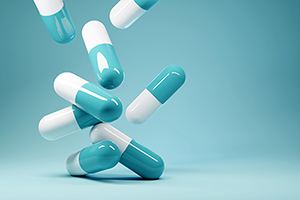



| By Dr. Ronald Hoffman

Last week, I shared the first nine in my list of the most common nutritional deficiencies that plague Americans. Now I’m rounding up the last nine, in an effort to keep you informed and on the lookout for potential gaps in your own nutrition.
Without further ado:
10) Choline: It’s estimated that more than 90% of Americans are not meeting the recommended daily intake of choline.
Choline is a nutrient important for liver health as well as a precursor to the neurotransmitter acetylcholine, essential for brain function. Choline is a contributor to methylation pathways; deficiencies in choline may cause homocysteine to soar. Pregnant women are urged to consume adequate choline to support fetal brain development.
It is found in fish, eggs and soy.
It was only in 1998 that RDIs were established for choline; many nutrition experts argue for raising thresholds for choline intake. An editorial in BMJ Nutrition urges, “More needs to be done to educate health care professionals and consumers about the importance of a choline-rich diet and how to achieve this.”
11) Zinc: About 12 percent of the population in the United States is probably at risk for zinc deficiency, and perhaps as many as 40 percent of the elderly, due to inadequate dietary intake and impaired absorption of this essential nutrient, according to an Oregon State University survey.
The problem is compounded by the paucity of accurate tests for zinc status; most people haven’t been tested, and, even if they were to be routinely screened, results poorly reflect optimal zinc levels.
Zinc plays a major role in wound healing and immunity. In the elderly, its insufficiency is implicated in immunosenescence—age-related progressive immune decline. In children and adolescents, adequate zinc is essential for normal growth and sexual maturation.
12) Magnesium: Perhaps the best example of a pervasive under-recognized nutritional deficiency, estimates are that somewhere between 40-60% of Americans have inadequate magnesium levels. The imprecision is due to inconsistencies among tests; a low magnesium on a standard blood test (serum magnesium) is relatively uncommon, except in sick hospital patients. More sensitive tests like red blood cell magnesium or magnesium load tests reveal the problem to be far more extensive. According to a recent review:
“Because serum magnesium does not reflect intracellular magnesium, the latter making up more than 99% of total body magnesium, most cases of magnesium deficiency are undiagnosed. Furthermore, because of chronic diseases, medications, decreases in food crop magnesium contents, and the availability of refined and processed foods, the vast majority of people in modern societies are at risk for magnesium deficiency.”
Symptoms of low magnesium are legion because the mineral participates in more than 300 biochemical reactions. They include—but are not limited to—anxiety and depression, weakness and fatigue, muscle twitching and cramps, high blood pressure, cardiac arrhythmias, asthma, heightened fracture risk, and migraines.
Many medications, especially diuretics and acid-blockers, predispose to magnesium deficiency. Ultra-processed foods are notoriously low in magnesium.
13) Vitamin B6: In a recent study, serum vitamin B6 was sufficient in 70.6% of participants, while 12.8% of the subjects were deficient in B6. For every increment in B6 status, there was a corresponding decrease in all-cause and cardiovascular mortality.
14) Folate: This B vitamin was in the cross-hairs in the 90s when it was demonstrated that it was a culprit in the incidence of neural tube defects in the offspring of folate-deficient women. Folate fortification of foods has ameliorated the problem to the point where it’s now estimated that less than 5% of Americans are folate deficient. Folate and foliage come from the same Greek root; as the name implies, green leafy vegetables are a main source. So, too, is liver.
Nevertheless, there’s an emerging consensus that some people, by virtue of weak genetically-determined methylation pathways like MTHFR, may require more folate to function optimally. Folate may confer protection against heart disease and certain cancers, as well as help with mood regulation.
15) Vitamin B12: In the United States and the United Kingdom, approximately 6% of adults younger than 60 years have vitamin B12 deficiency, but the rate is closer to 20% in those older than 60. But the problem lies in the criteria for B12 deficiency. With a standard cutoff of 200 pg/dL, a person with a B12 of 300 might be considered replete, but subtle symptoms of B12 inadequacy may plague them.
Symptoms include fatigue; palpitations; pale skin; dementia; weight loss; and infertility. Neurological changes, such as numbness and tingling in the hands and feet, can also occur. Low B12 may also contribute to depression.
Reasons for B12 insufficiency include inadequate intake of animal protein, acid-blocking medication, and an autoimmune condition called pernicious anemia. B12 supplements, and sometimes shots, may be necessary to overcome barriers to B12 uptake.
16) Omega 3: According to a recent study, over 95% of children and 68% of adults had omega-3 concentrations below those associated with the Dietary Guidelines recommendations. Moreover, the Omega 3 Index scores of 89% of adults placed them in the “high cardiovascular risk category”.
Inadequate Omega 3s may contribute to neurodegenerative diseases, mood impairments, inflammatory disorders, skin problems, cardiovascular issues, musculoskeletal problems and eye and skin conditions.
Humans can make EPA and DHA from alpha-linolenic acid found in nuts and some vegetables like purslane, but many people are genetically incapable of making enough from non-marine sources. Hence, consumption of oily fish and/or supplementation is imperative to achieve adequate levels of Omega 3s.
17) Protein: When we talk about nutritional deficiencies we seldom think about protein since it’s so ubiquitous in our diets. But there’s new-think on protein that argues that many Americans are scrimping on this vital macronutrient.
It turns out that seniors may have higher protein requirements than younger adults. That’s because a process called sarcopenia progressively robs the elderly of muscle mass, leading to frailty; adequate protein, especially when rich in branched chain amino acids, appears to partially allay this degenerative process.
Reduced appetite, impairments of taste and smell, and age-related declines in hydrochloric acid and pancreatic enzyme production may compromise protein uptake in seniors.
Other stressors call for additional protein intake: Amateur and professional athletes should strive for one gram of protein per pound of body weight daily; individuals recovering from major surgery may also require additional protein to facilitate wound healing.
18) Lutein: Along with its companion nutrient zeaxanthin, lutein is essential for eye health. It’s a carotenoid pigment that protects the retina from free radical damage, which can lead to macular degeneration.
But it also does more: It’s been shown to shield against prostate cancer; it can help combat inflammation in individuals with metabolic syndrome; higher blood concentrations of lutein confer circulatory benefits; it may slow skin-aging; lutein was positively associated with brain structure and neural efficiency during cognitive tasks; lutein is even a component in many hair formulas.
Lutein is found in spinach and many leafy and cruciferous greens; eggs and green peas are also good sources.
For overall health, it is suggested that we need 10 mg or more of lutein per day. But it’s estimated that Americans consume an average of only 1–3 mg of lutein and zeaxanthin daily.
I hope you’ve found this two-part round-up informative, and encourage you to take steps to ensure your diet contains plenty of the nutrients I’ve covered in these two articles. It might also be wise to confer with your health provider—preferably one who is attuned to nutrition—at your next routine check-up, and explore the possibility of evaluating your levels of the above mentioned nutrients to determine your current levels.
Though we think of declining estrogen as the hallmark of menopause, it's actually common for…

Up to 12 percent of Americans have ulcers at some point in life. Peptic ulcers…
Gallbladder disease is a modern illness. An estimated 20 million Americans have gallbladder disease. The…

It seems not a week goes by that we’re not regaled with news of a…

Last week, I discussed possible reasons for low ferritin levels. As with most blood tests,…

I just returned from a dive trip to Turks and Caicos and wanted to share…

ENCORE: Factors That Affect Fertility, Part 1

Our virtual voicemail is open 24/7, so there's no need to wait to submit your questions for Dr. Hoffman. Leave a message, and you may hear your question featured on the Intelligent Medicine radio program!